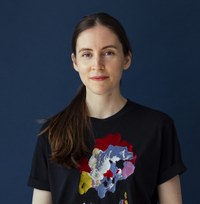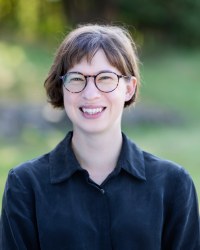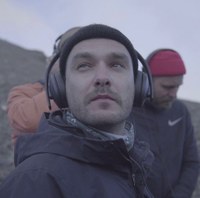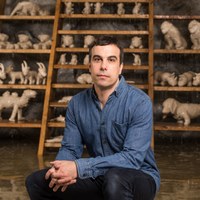Current Fellows
Fellows Planetary Scholars & Artists in Residence Program 2024: Planetary Times
Connor Cook
|
Connor Cook is a media artist and researcher from California, currently based in Amsterdam. His work unravels the recursive relationships between technical systems and their broader ecological and cultural contexts through a practice of “computational performance.” Through audiovisual performances, he translates the complex dynamics of these interactions into collective, affective experiences that double as forms of critique. He holds an MA in GEO—DESIGN from the Design Academy Eindhoven and a BA in the History of Art and Architecture from Harvard University.
|
|
 |
|
Project: Bioreactors and Biospheres: An Audiovisual Exploration of Evolution as Worldbuilding The evolution of life on Earth corresponds with an evolution in the information processing capacities of the planet. From the molecular to the macroscopic, information drives processes, shapes behavior, and underpins the functioning of planetary systems. In recent decades, the proliferation of computational systems has vastly increased the volume of information coursing through the planet. Today, informatic flows traverse both biological and technical domains, intertwining the biosphere and technosphere in ongoing recursive feedback loops. The project aims to replicate this recursive dynamic on a micro-scale, using a Raspberry Pi-enabled bioreactor (Pioreactor) combined with an immersive audiovisual software environment. The Pioreactor can cultivate, monitor, and control cultures of yeast, bacteria, and algae through real-time two-way communication with a computer. During the workshop, algae will be used due to its significance in the historical Great Oxygenation Event—a form of "world-building" that enabled the further development of life on Earth. By algorithmically adjusting and monitoring the balance of light, nutrients, carbon dioxide, and algal growth, the project will employ the Pioreactor environment as a simplified planetary model, illustrating the intricate interplay of biological matter, energy, and information. The real-time data produced in the Pioreactor will shape audiovisual representations in immersive software environments. This informatic relay allows the micro-scale dynamics to be magnified and experienced on a human scale. In doing so, the project aims to bridge connections across spatiotemporal scales and explore questions of agency, control, and information by orchestrating interactions between microbial and human cultures. The project will be carried out in collaboration with Darren Zhu, a synthetic biologist and metascientist. He has worked with a range of biotech startups including fungal natural products company Hexagon Bio, genome engineering company Enevolv, and diagnostic biosensor company Synbiosys, and research organizations including the Berggruen Institute, Ethereum Foundation, and Gates Foundation. He holds a BA in Molecular, Cellular, and Developmental Biology from Yale University. |
Aisling O'Carroll
|
Aisling O'Carroll is a designer and researcher, trained in both architecture and landscape architecture. She is currently completing her GRS/ORS-funded PhD in Architectural Design at The Bartlett School of Architecture, UCL, where her work addresses the relations between history, narrative, and representation in architecture, landscape, geology, and hybrids of the three—examining, in particular, critical approaches to reconstruction as design. Since 2020, she has been Programme Coordinator for the graduate landscape architecture programmes at The Bartlett, where she also served as Interim Programme Director for Landscape Architecture between 2022 and 2023. |
|
 |
|
Project: Reconstructing Planetary Timescales at the Unteraargletscher This project will explore how techniques of reconstruction, drawn from geology, architecture, and archaeology, can translate knowledge about geological histories and the relations between planetary and human timescales. Through a case study investigation of the Unteraar glacier in the Bernese Oberland, observations from fieldwork and research will be used to produce a series of maps, models, and animations that examine different histories and layers of the site. The Unteraar glacier demonstrates the convergence of perceptible and beyond-human-conception timescales through its past, present, and future. As a site embedded within political, infrastructural, cultural, and planetary forces, it can be read through multiple lenses and understood across many chronologies. The aim of the work is to test the ability and limitations of different reconstruction methods to render visible the overlaps, synchronicities, and disruptions across spatial and temporal scales. Simultaneously, the work aims to open conversations about alternative approaches to planetary-scale issues in the future through the more inclusive and expansive understanding of time and space fostered by these interdisciplinary methods. |
Charlotte Wrigley
|
Charlotte Wrigley is a research fellow at the Greenhouse Environmental Humanities Center at the University of Stavanger. Her research sits at the intersection between human geography, environmental humanities, and more-than-human studies, with a particular emphasis on the Arctic and northern environments. She is currently the principal investigator of ‘Good Fire’, a study into prescribed burning and fire ecologies in boreal landscapes, and has conducted projects on Arctic rewilding, subterranean boreholes, and permafrost. She is the author of the book Earth Ice Bone Blood: Permafrost and Extinction in the Russian Arctic, which was the recipient of the 2023 AAG Globe Prize for public understanding of geography. |
|
 |
|
Project: Eternity in the Anthropocene: Freezing Time in a Thawing World This project will critically interrogate the word ‘eternity’ through a comparative analysis of two so-called eternal timeframes: that of the permafrost which is thawing rapidly due to global heating, and cryobanks that promise temporal preservation through cold storage methods. Rooting the project are the case studies of the unfinished Soviet ‘Subterranean Museum of Eternity’ sunken into a permafrost tunnel, and Europe’s only human cryopreservational facility ‘Tomorrow Biostasis’. These are material entities that hold together, and mediate, both geological and human time – yet they are conceived of as radical opposites: the museum encompassing a deep earthly past, whilst the cryogenic facility is a future banking institution responding to time running out for planetary survival, offering redemption to the super rich. The assumed eternity of planetary processes such as robust permafrost and habitable temperatures have become replaced by technological fixes that promise mastery over catastrophic futures. This project challenges these conceptions and instead seeks to produce a more generative definition of eternity by holding geological and human temporalities in dialogue. By employing an interdisciplinary methodology that comprises scientific literature, artistic imaginaries, and environmental humanities methods, it will critically analyse both the geologic definition of eternity through the permafrost tunnel, and the social definition of eternity through the cryo-facility, then speculatively imagine eternal temporalities that think beyond these binaries. |
Lukáš Likavčan
|
Lukáš Likavčan is a philosopher. His research focuses on philosophy of science & technology and environmental philosophy. He is a Global Perspective on Society Postdoctoral Fellow at NYU Shanghai, and a guest researcher at Astronomy & Society Group, Leiden University. Likavčan is an author of Introduction to Comparative Planetology (2019) and a member of More-than-Planet Working Group at Waag Futurelab. He is currently preparing his next monograph. |
|
 |
|
Project: Comparative Planetology of History This project combines situated methods of philosophical writing with elements of multimodal, collaborative knowledge-making. The main claim of this project is that planets are in essence historical, dynamical entities – they exist as concentrated crystallization of cosmic time. Elaborating on the author’s previous work, the project uses the astronomical perspective to think about history in plural – i.e. to make a comparative study of planets in terms of their histories, which are contingent on different initial parameters the host solar system affords. During the project, Likavčan aims to develop a series of diagrams exploring how these various historical trajectories impact our understanding of the Earth alongside the boundaries of human inhabitation of this planet. |
Christian Kosmas Mayer (Publication Fellowship)
|
Christian Kosmas Mayer is an artist whose work produces and preserves a constellation of narratives about historical remains and representations that are often on the verge of disappearing, or have already been rendered imperceptible. His projects, which are the outcome of extensive artistic research and close collaborations with specialists across various disciplines, transform the minor, forgotten, and obsolescent into material artifacts, discursive objects, multi-media installations, and performances. He has had solo exhibitions in prestigious institutions like mumok – Museum moderner Kunst Stiftung Ludwig Wien, Austria; Belvedere Museum, Vienna, Austria; Austrian Cultural Forum New York, USA; MAK Center, Los Angeles, USA; and many more. Mayer also performs and releases music in various constellations. |
|
 |
|
Project: De-extinction The project delves into the transformative domain of "de-extinction," a scientific venture where cutting-edge techniques such as genetic engineering and cloning are utilized to revive species that have vanished from our planet. Artist Christian Kosmas Mayer and cultural-environmental geographer Adam Searle synergize their expertise in artistic research, continental philosophy, and social science to navigate and elucidate this new intermediate state that straddles the boundaries between life and death, offering a fresh perspective on existence. Their joint examination of this topic over the years, encapsulated in a thought-provoking essay, employs a diverse array of methodologies, including ethnographic studies and experimental research, aiming to dissect, redefine, and vividly portray this liminal space they call 'anabiosis'. This innovative approach offers novel insights into the complex interplay between life, death, and the potential for life's resurgence, challenging our perceptions of permanence and loss. Through this exploration, Mayer and Searle not only contribute to the artistic, scientific and philosophical discourse on de-extinction but also highlight the role of interdisciplinary approaches in uncovering the complexities of existence in the post-genomic era of the Anthropocene. |
